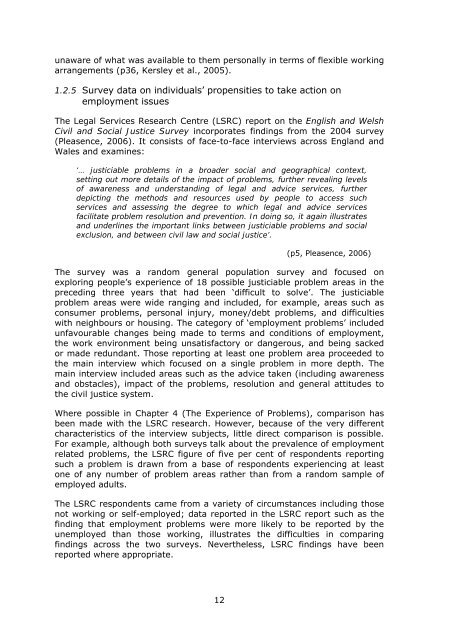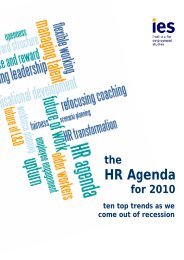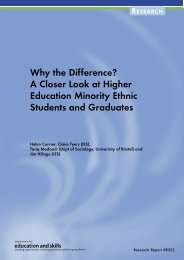Employment Rights at Work: Survey of Employees ... - DTI Home Page
Employment Rights at Work: Survey of Employees ... - DTI Home Page
Employment Rights at Work: Survey of Employees ... - DTI Home Page
- No tags were found...
You also want an ePaper? Increase the reach of your titles
YUMPU automatically turns print PDFs into web optimized ePapers that Google loves.
unaware <strong>of</strong> wh<strong>at</strong> was available to them personally in terms <strong>of</strong> flexible workingarrangements (p36, Kersley et al., 2005).1.2.5 <strong>Survey</strong> d<strong>at</strong>a on individuals’ propensities to take action onemployment issuesThe Legal Services Research Centre (LSRC) report on the English and WelshCivil and Social Justice <strong>Survey</strong> incorpor<strong>at</strong>es findings from the 2004 survey(Pleasence, 2006). It consists <strong>of</strong> face-to-face interviews across England andWales and examines:‘… justiciable problems in a broader social and geographical context,setting out more details <strong>of</strong> the impact <strong>of</strong> problems, further revealing levels<strong>of</strong> awareness and understanding <strong>of</strong> legal and advice services, furtherdepicting the methods and resources used by people to access suchservices and assessing the degree to which legal and advice servicesfacilit<strong>at</strong>e problem resolution and prevention. In doing so, it again illustr<strong>at</strong>esand underlines the important links between justiciable problems and socialexclusion, and between civil law and social justice’.(p5, Pleasence, 2006)The survey was a random general popul<strong>at</strong>ion survey and focused onexploring people’s experience <strong>of</strong> 18 possible justiciable problem areas in thepreceding three years th<strong>at</strong> had been ‘difficult to solve’. The justiciableproblem areas were wide ranging and included, for example, areas such asconsumer problems, personal injury, money/debt problems, and difficultieswith neighbours or housing. The c<strong>at</strong>egory <strong>of</strong> ‘employment problems’ includedunfavourable changes being made to terms and conditions <strong>of</strong> employment,the work environment being uns<strong>at</strong>isfactory or dangerous, and being sackedor made redundant. Those reporting <strong>at</strong> least one problem area proceeded tothe main interview which focused on a single problem in more depth. Themain interview included areas such as the advice taken (including awarenessand obstacles), impact <strong>of</strong> the problems, resolution and general <strong>at</strong>titudes tothe civil justice system.Where possible in Chapter 4 (The Experience <strong>of</strong> Problems), comparison hasbeen made with the LSRC research. However, because <strong>of</strong> the very differentcharacteristics <strong>of</strong> the interview subjects, little direct comparison is possible.For example, although both surveys talk about the prevalence <strong>of</strong> employmentrel<strong>at</strong>ed problems, the LSRC figure <strong>of</strong> five per cent <strong>of</strong> respondents reportingsuch a problem is drawn from a base <strong>of</strong> respondents experiencing <strong>at</strong> leastone <strong>of</strong> any number <strong>of</strong> problem areas r<strong>at</strong>her than from a random sample <strong>of</strong>employed adults.The LSRC respondents came from a variety <strong>of</strong> circumstances including thosenot working or self-employed; d<strong>at</strong>a reported in the LSRC report such as thefinding th<strong>at</strong> employment problems were more likely to be reported by theunemployed than those working, illustr<strong>at</strong>es the difficulties in comparingfindings across the two surveys. Nevertheless, LSRC findings have beenreported where appropri<strong>at</strong>e.12
















